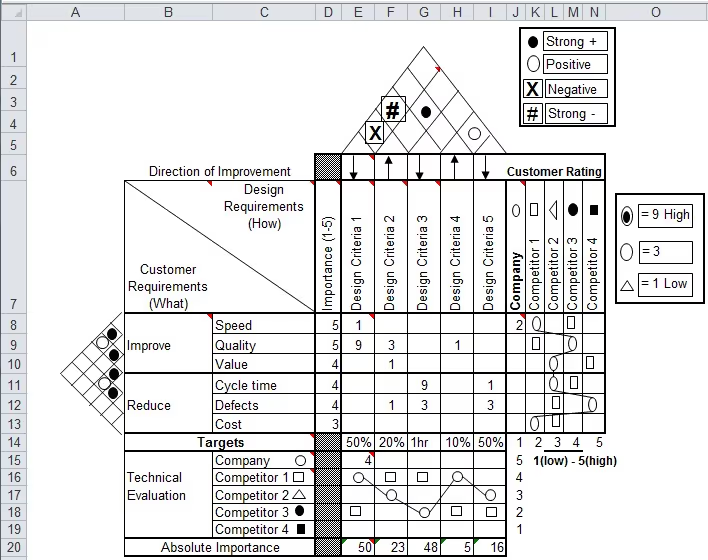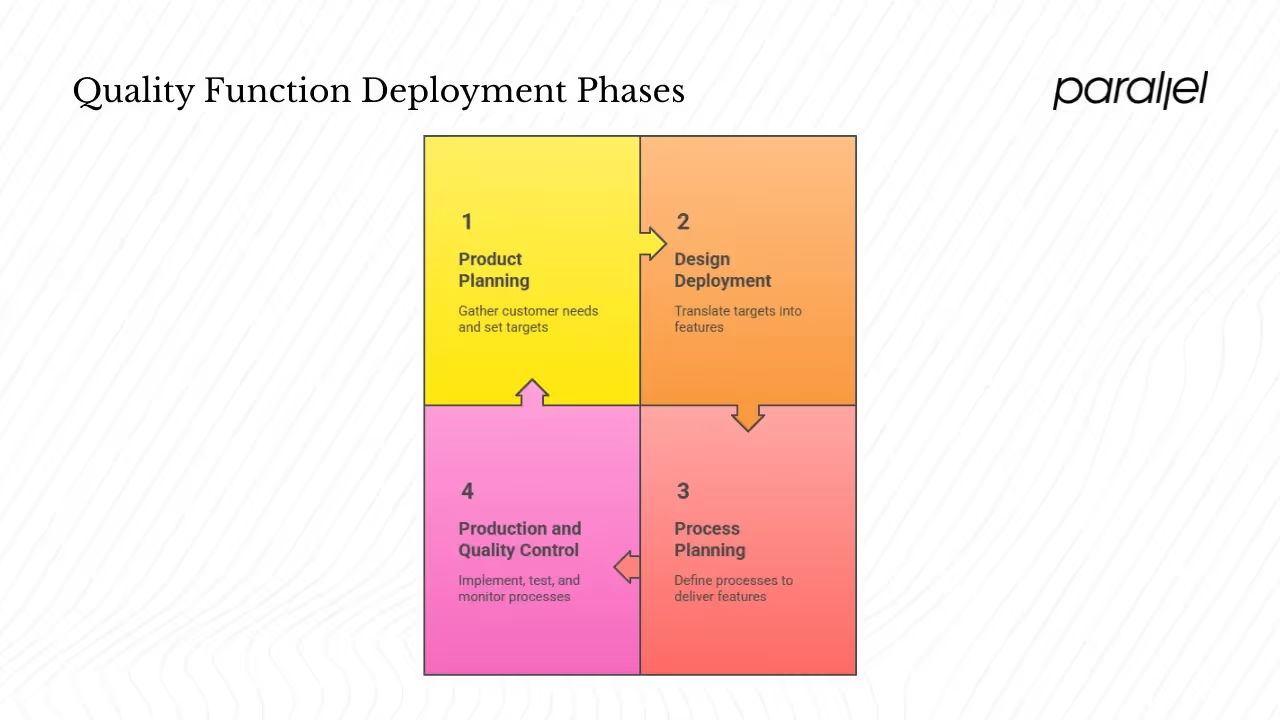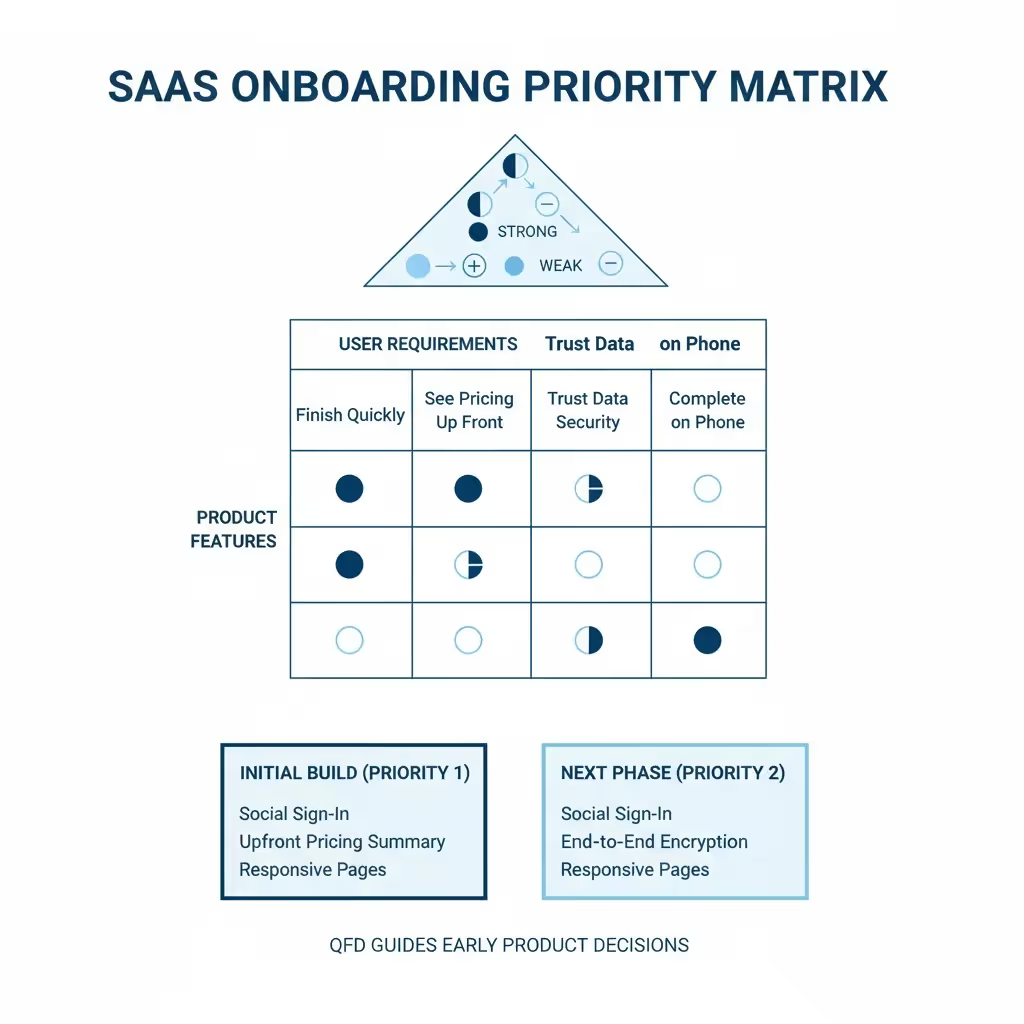What Is Quality Function Deployment? Guide (2026)
Discover quality function deployment (QFD), a method that translates customer needs into engineering characteristics.

Too many early‑stage teams build products on assumptions and later realise they missed the mark. Quality Function Deployment (QFD) fixes this by translating the voice of the customer into measurable engineering requirements so every decision traces back to what users value. In this guide I explain QFD’s roots, core tools, a practical process and a real‑world example for startups. By the end you’ll know exactly what quality function deployment and how to use it.
What is quality function deployment?
QFD is a tool that helps translate user needs into product features, design elements, and technical goals. It’s often visualized in a matrix called the House of Quality, which shows how different design or technical features support user wants and needs.

Quality Function Deployment was born in Japan’s manufacturing renaissance of the late 1960s. Yoji Akao and Shigeru Mizuno wanted to give engineers a way to convert vague customer wishes into precise design targets. Working in industries such as shipbuilding, they realised that designers needed more than intuition to make the right calls. Their approach quickly spread across Toyota and other manufacturers and later found its way into healthcare, services and software.
This historical context matters because it illuminates what is quality function deployment at its core: a philosophy of turning qualitative desires into quantitative specs and then “deploying” quality throughout every layer of the organisation. Rather than guessing what customers need, teams collect the voice of the customer and methodically translate it into measurable requirements. The philosophy emphasises continuous improvement—feedback from customers loops back into the system so that products evolve with real use. QFD also complements process‑focused methods like Six Sigma by providing a front‑end discipline that aligns cross‑functional teams around user needs.
Think of QFD as a bridge: it connects the human expressions of value with the technical language of engineering. It doesn’t replace creativity or agile experimentation; instead, it grounds innovation in evidence and reduces the risk of building something nobody cares about.
Core concepts
1) Voice of the customer
In QFD, everything starts with the voice of the customer (VOC). This term simply means the expressed or observed needs of your users. You gather the VOC through research—surveys, interviews, feedback logs and usability sessions—and then convert those raw comments into clear requirement statements. For example, “the signup feels long” becomes “onboarding should take less than three minutes.” Teams then ask users to rank or rate these requirements to understand which matter most.
2) What’s versus how’s
A central idea in QFD is distinguishing between what the customer wants and how the product will deliver it. What is the need expressed in the customer’s language—“clear pricing,” “fast onboarding.” The how is the technical feature that satisfies that need—“display transparent pricing tables,” “enable social sign‑in.” Mapping what’s to anchor every design decision to a specific requirement and helps teams see the downstream impact of technical choices.
3) House of Quality and matrix diagrams
To structure this mapping, QFD uses a series of matrices. The first and most recognisable is the House of Quality, a grid where customer requirements form the rows, technical characteristics form the columns and each cell shows the strength of their relationship. A simple 0/1/3/9 scoring (none, weak, medium, strong) captures how well a feature satisfies a requirement. The triangular “roof” on top highlights positive or negative correlations among technical features, so teams can spot conflicts early. Additional sections hold importance scores and target values. The House of Quality is just the beginning; later matrices carry the requirements down to subsystems and processes.
4) Prioritisation and importance weighting
Not all requirements carry the same weight. Teams use prioritisation matrices—simple rating scales or pairwise comparisons—to see which needs rise to the top. These scores multiply with the relationship values in the House of Quality to show which technical features matter most. Decision matrices and trade‑off analysis help resolve conflicts while considering constraints such as cost or feasibility.
5) Cross‑functional collaboration and traceability
QFD succeeds when it brings diverse perspectives together. Product managers, engineers, designers and operations specialists collaborate in workshops to agree on requirements, scores and correlations. Every technical decision is traced back to a customer requirement, making trade‑offs transparent and enabling continuous alignment as feedback rolls in. Understanding these terms clarifies what is quality function deployment and how it anchors design decisions in real user needs.
QFD in practice: four phases and tools
Four cascaded phases
QFD unfolds over four cascading phases:
- Product planning: Gather and prioritise customer requirements, then build the House of Quality to set high‑level targets.
- Design deployment: Translate those targets into subsystem or component features using secondary matrices.
- Process planning: Define the processes or workflows needed to deliver those features, including quality controls.
- Production and quality control: Implement, test and monitor the process; feed what you learn back into earlier phases.

In software, design deployment refers to modules or APIs, process planning to release pipelines and operations, and production to monitoring and support. Regardless of the domain, the idea is to flow user needs down to every level.
Step‑by‑step workflow
To apply QFD, follow a sequence similar to agile discovery but with more structure:
- Listen and prioritise. Capture the voice of the customer through research, translate feedback into requirement statements and assign importance scores.
- Propose how’s. Brainstorm technical features or design attributes that could satisfy each requirement and ensure each is measurable.
- Build the matrix. Assemble your House of Quality: list requirements and features, score their relationships using 0/1/3/9 and add importance weights. The roof helps you spot conflicts.
- Calculate and decide. Multiply the scores and weights to see which features contribute most, then resolve trade‑offs based on constraints like cost and feasibility.
- Cascade and refine. Use the chosen features as inputs to subsequent phases, gather feedback from prototypes or releases and update the matrix as you learn.
This workflow can be simple or detailed depending on your context. Either way, it offers a clear path from customer insight to design action, answering the question of quality function deployment in practical terms.
When should a startup use QFD?
Use QFD when you’ve started identifying real user needs and are ready to prioritise what to build next. It’s not meant for blank-slate ideation, but it works well when you want to align your team and reduce the risk of shipping the wrong thing.
Here’s a quick check to see if it’s the right time:
✅ Good time to use QFD
- You’ve done interviews, surveys, or logged feedback and have a basic understanding of what users care about.
- You need to prioritise competing features and want a clear, structured method.
- Your product, design, and engineering teams need a shared understanding of customer priorities.
- You’re preparing for a major sprint, roadmap cycle, or release planning session.
🕒 Maybe wait or start smaller
- You’re still exploring your problem space and haven’t collected much real user input yet.
- Your team is very early-stage and may not have the bandwidth for structured workshops.
- You’re in pure discovery mode and still testing different user problems.
🧭 Lightweight alternative for early-stage teams
If you’re not ready for a full matrix, try this:
- Pick 3–5 core user needs based on your best current data.
- Brainstorm a few feature ideas that might satisfy each.
- Quickly score them in a shared doc using a simple 0/1/3/9 scale.
- Use those scores to decide what goes in your next sprint or prototype.
This keeps you focused on real needs without overcomplicating things. You can always expand into a fuller QFD as your product and team mature.
Case example and startup tips
A simple SaaS onboarding matrix
Imagine a young SaaS company designing its onboarding flow. Through interviews and surveys, the team identifies four key requirements—finish quickly, see pricing up front, trust data security and complete the process on a phone. They brainstorm four features to address them: social sign in to reduce typing, an upfront pricing summary, end‑to‑end encryption and responsive pages.
After asking a handful of users to rate the importance of each requirement and estimating how strongly each feature meets them, the team populates a small House of Quality. The matrix shows that social sign‑in strongly satisfies speed and mobile access, while pricing summaries matter most for transparency. Encryption scores highest on trust. With these insights, the team decides to build social sign‑in and pricing transparency first and schedule encryption and responsiveness next. Even in this stripped‑down form, the method clarifies priorities and demonstrates how quality function deployment can guide early decisions.

Practical tips for startups
For early‑stage teams, QFD can feel heavy. To keep it lean:
- Limit scope. Focus on just a handful of requirements and features to avoid overwhelming complexity.
- Keep scoring simple. A three‑point or 0/1/3/9 scale is usually sufficient; finer granularity rarely improves decisions.
- Collaborate early. Invite product, engineering, design and operations to one workshop so everyone aligns on needs and constraints.
- Iterate, don’t engrave. Treat your matrix as a living document that evolves with new insights and sprints. This adaptive approach clarifies how QFD supports teams balancing speed and quality.
Benefits, challenges and best practices
Benefits
Applied thoughtfully, QFD aligns teams around customer needs and reduces rework. By turning vague desires into concrete targets, it shortens development cycles and keeps efforts focused on what users value. Such programmes improve retention and revenue, and aligning features with VOC helps prevent churn; Zendesk’s 2025 study found that 73 percent of consumers switch after repeated bad experiences and 79 percent will switch if they find a better customer experience.
Challenges
QFD requires discipline and can be time‑intensive. Scoring is subjective, so stakeholders may disagree on importance or correlation values. Over‑engineering the matrix can lead to analysis paralysis, while oversimplifying it can give a false sense of certainty. Adapting a method born in manufacturing to software demands thoughtful translation; modules, APIs and release pipelines replace parts and processes. Without good VOC data, the outputs are unreliable—garbage in, garbage out. Appreciating these constraints helps you stay grounded when answering what is quality function deployment.
Best practices
To capture the upside while avoiding pitfalls:
- Start small and simple: Limit yourself to a few requirements and features, and use coarse scales for scoring.
- Collaborate and evolve: Bring product, engineering, design and operations into the room to agree on scores and treat the matrix as a living document that updates with each release. These practices help you apply what is quality function deployment in a lean and practical way.
Conclusion
Quality Function Deployment gives startups a disciplined yet flexible way to bridge the gap between what customers ask for and what engineers build. It begins with the voice of the customer and cascades requirements through design, development and operations. By translating qualitative insights into quantitative targets, prioritising competing demands and exposing trade‑offs, QFD reduces rework and improves cross-functional collaboration. You don’t need a gigantic matrix to see benefits; even a small, focused QFD can sharpen your priorities and align your team. So, what is quality function deployment? It’s a practical framework for turning empathy into action. Try a lightweight version on your next feature and see how it clarifies your choices.
Frequently asked questions
1) What do you mean by quality function deployment?
It’s a structured way to turn what customers say into engineering specifications. QFD uses tools like the House of Quality to map needs to features and prioritise them so the finished product aligns with customer value.
2) What are the four phases of QFD?
They are product planning, design deployment, process planning and production/quality control. Each phase takes the customer’s voice from high‑level needs down to detailed specifications.
3) How do I do a quality function deployment?
First collect the voice of the customer, translate it into clear requirements and rank them. Then brainstorm how to satisfy each requirement, build a House of Quality, calculate scores to see which features matter most, make trade‑offs and refine the matrix as you learn.
4) What does a quality function do?
In QFD, a “quality function” is a technical characteristic that satisfies a customer requirement—it’s the how to a user’s what. For “easy onboarding,” the quality function might be social sign in or auto‑fill data fields.
5) When should a startup use QFD?
Use QFD when you have some insight into your users and need to prioritise features or reduce assumption risk. If you are still exploring the problem space, start small and iterate.
6) How does QFD relate to agile and lean development?
QFD complements agile by giving you a structured way to prioritise and trace features back to user needs. Use it to guide backlog grooming and sprint planning while staying flexible through lean experimentation.
7) What are the limitations or risks of QFD?
Scoring is subjective and building matrices takes time. Keep scales simple, limit scope and treat the matrix as a living document to avoid overcomplication and reliance on poor data.






.avif)






